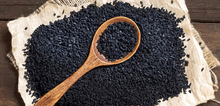Nigella sativa
| Nigella sativa | |
|---|---|
 | |
| Scientific classification | |
| Kingdom: | Plantae |
| (unranked): | Angiosperms |
| (unranked): | Eudicots |
| Order: | Ranunculales |
| Family: | Ranunculaceae |
| Genus: | Nigella |
| Species: | N. sativa |
| Binomial name | |
| Nigella sativa L. | |
| Synonyms[1] | |
| |

Nigella sativa (black-caraway,[2] also known as nigella or kalonji), often called black cumin,[3][4] is an annual flowering plant in the family Ranunculaceae, native to south and southwest Asia.
Nigella sativa grows to 20–30 cm (7.9–11.8 in) tall, with finely divided, linear (but not thread-like) leaves. The flowers are delicate, and usually colored pale blue and white, with five to ten petals.
The black caraway fruit is a large and inflated capsule composed of three to seven united follicles, each containing numerous seeds which are used as spice, sometimes as a replacement for black cumin (Bunium bulbocastanum).

Etymology
The genus name Nigella is a diminutive of the Latin niger (black), referring to the seeds.[5]
Common names
In English, Nigella sativa and its seed are variously called black-caraway, black-cumin, fennel-flower, nigella, nutmeg-flower, Roman-coriander,[3] and kalonji (from Hindi).[6]
Blackseed and black caraway may also refer to Bunium persicum.[7]
Culinary uses

The seeds of Nigella sativa are used as a spice in Indian and Middle Eastern cuisines. The black seeds taste like a combination of onions, black pepper and oregano. They have a pungent bitter taste and smell.[6]
The dry-roasted nigella seeds flavor curries, vegetables and pulses. It can be used as a "pepper" in recipes with pod fruit, vegetables, salads and poultry. In some cultures, the black seeds are used to flavor bread products. It is also used as part of the spice mixture panch phoron (meaning a mixture of five spices) and by itself in many recipes in Bengali cuisine and most recognizably in naan bread.[8] Nigella is also used in Armenian string cheese, a braided string cheese called majdouleh or majdouli in the Middle East.
History
Archaeological evidence about the earliest cultivation of N. sativa "is still scanty", but N. sativa seeds were found in several sites from ancient Egypt, including Tutankhamun's tomb.[9] Seeds were found in a Hittite flask in Turkey from the second millennium BCE.[10]
N. sativa may have been used as a condiment of the Old World to flavor food.[9] The Persian physician, Avicenna, in his Canon of Medicine, described N. sativa as a treatment for dyspnea.[11]
Chemistry
Nigella sativa oil contains conjugated linoleic (18:2) acid, thymoquinone, nigellone (dithymoquinone),[12] melanthin, nigilline, and trans-anethole.[6]
Research
Preliminary studies have investigated claims from traditional medicine that N. sativa has efficacy as a therapy, mainly using the seed oil extract, volatile oil, and isolated constituent thymoquinone.[13] One meta-analysis of clinical trials found weak evidence that N. sativa has a short-term benefit on lowering systolic and diastolic blood pressure, and another found limited evidence that various extracts of black seed can reduce triglycerides, LDL and total cholesterol while raising HDL cholesterol.[14][15]
References
- ↑ "The Plant List: A Working List of All Plant Species".
- ↑ "BSBI List 2007". Botanical Society of Britain and Ireland. Archived from the original (xls) on 2015-02-25. Retrieved 2014-10-17.
- 1 2 "USDA GRIN Taxonomy".
- ↑ Heiss, Andreas (December 2005). "The oldest evidence of Nigella damascena L. (Ranunculaceae) and its possible introduction to central Europe". Vegetation History and Archaeobotany. 14 (4): 562–570. JSTOR 23419312. doi:10.1007/s00334-005-0060-4. (Registration required (help)).
- ↑ Hyam, R. & Pankhurst, R.J. (1995). Plants and their names : a concise dictionary. Oxford: Oxford University Press. ISBN 978-0-19-866189-4. p. 341.
- 1 2 3 Bharat B Aggarwal. Molecular Targets and Therapeutic Uses of Spices. Google Books. p. 259. ISBN 978-981-4468-95-4. Retrieved 4 January 2015.
- ↑ Bunium persicum - (Boiss.) B.Fedtsch. Common Name Black Caraway
- ↑ Bramen L (16 February 2011). "Nigella Seeds: What the Heck Do I Do with Those?". smithsonian.com. The Smithsonian Online. Retrieved 4 January 2015.
- 1 2 Zohary, Daniel; Hopf, Maria (2000). Domestication of plants in the Old World (3 ed.). Oxford University Press. p. 206. ISBN 0-19-850356-3.
- ↑ Saliha B, Sipahib T, Oybak Dönmez, E (2009). "Ancient nigella seeds from Boyalı Höyük in north-central Turkey". Journal of Ethnopharmacology. 124 (3): 416–20. doi:10.1016/j.jep.2009.05.039.
- ↑ Avicenna (1999). Canon of Medicine. Chicago: Kazi Publications.
- ↑ Mohammad Hossein Boskabady; Batool Shirmohammadi (2002). "Effect of Nigella Sativa on Isolated Guinea Pig Trachea" (PDF). Arch. Iran. Med. 5 (2): 103–107.
- ↑ Ali BH, Blunden G (2003). "Pharmacological and toxicological properties of Nigella sativa". Phytother Res. 17 (4): 299–305. PMID 12722128. doi:10.1002/ptr.1309.
- ↑ Sahebkar A, Soranna D, Liu X, et al. (2016). "A systematic review and meta-analysis of randomized controlled trials investigating the effects of supplementation with Nigella sativa (black seed) on blood pressure". J Hypertens. 34 (11): 2127–35. PMID 27512971. doi:10.1097/HJH.0000000000001049.
- ↑ Sahebkar A, Beccuti G, Simental-Mendía LE, et al. (2016). "Nigella sativa (black seed) effects on plasma lipid concentrations in humans: A systematic review and meta-analysis of randomized placebo-controlled trials". Pharmacol Res. 106: 37–50. PMID 26875640. doi:10.1016/j.phrs.2016.02.008.
External links
| Wikimedia Commons has media related to Nigella sativa. |